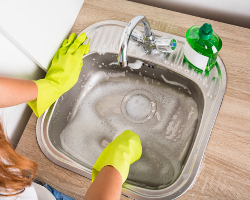PEST LIBRARY / FLIES / PHORID HUMPBACKED FLY / HOW TO GET RID OF PHORID HUMPBACKED FLIES
Phorid humpbacked flies are a member of the Family Phoridae, which has around 3,500 identified species worldwide. They are also known as 'coffin flies', 'sewer flies' or ‘scuttle flies’.
In homes and businesses, these flies develop and breed wherever there is moisture, any time of the year. They commonly develop in and feed on the moist organic matter that can accumulate deep in plumbing, drains and garbage disposals. Other areas include around plumbing and drains in kitchens, bathrooms and laundry rooms, under and between kitchen appliances, garbage containers, recycling receptacles, septic systems, sewers, basements, crawl spaces and in decaying flesh. Finding these flies in your home can be a sign that you have a dead animal in your home.
Phorid humpbacked flies are a sanitation issue and are often challenging to get rid of because of where they develop and breed, which is often deep with pipes and around septic systems. Dealing with these unsanitary pests can be expensive, and may require help from a plumber, contractor and pest management professional to help you find the root of the problem.
While phorid humpbacked flies can be an issue in homes, they are more often issues for food service industry and food processing and food warehousing facilities.
Phorid Humpbacked flies are 0.6 to 6 mm long, with dark eyes. They vary in colouring, from black to dull brown to yellow. Their thorax is arched which gives them a humpbacked appearance (which they are named after).

They are weak flyers and often scurry erratically across surfaces. They are commonly confused with fruit flies or gnats and need to be correctly identified by a pest control professional.
The average lifespan of a phorid humpbacked fly is one to two months, which is dependent on their environment.
Similar to other small flies, their life cycle has 4 phases - egg, larva, pupa and adult. Female phorid humpbacked flies typically lay 20 eggs at a time and around 500 eggs in their adult lifespan in the same unsanitary places where they feed. Phorid humpbacked fly larvae can even develop in standing water. Depending on their habitat and environment, they move from egg to adult in just 2 to 3 weeks.
They feed on (and breed in) the damp organic matter deep within drains, pipes, sewage, feces, decaying fruits, vegetables and meats, fungi garbage, dead animals, other insects, and even human cadavers. All of the above provide nourishment at the various stages of their lifecycle.
Their unsanitary feeding and breeding habits spread bacteria and disease. They contaminate whatever they have infested and any counters, items, surfaces or other food and stored pantry items they come into contact with.
No, they do not bite humans and pets. They are an unsanitary nuisance pest.
Phorid humpbacked flies carry bacteria and can transmit diseases.
For the food service industry and food processing, handling and storage facilities, they are a very serious health concern and are a large financial cost to address. It can be expensive locating the source of the infestation and repairing it if needed, plus there is the cost of sanitation, disposing of contaminated food and lost business if temporary closure is needed to deal with the issue.
These flies develop and breed wherever moisture exists, commonly deep within drains and plumbing where organic materials accumulate. Because these areas are not often thoroughly cleaned (to the point where the organic materials are broken down and cleared), and the flies can breed and mature quickly, and they are often confused with other small flies, a phorid humpbacked fly infestation can arise and catch a home or business owner by surprise.
Sighting many adult flies in your home or business is a true sign of a phorid humpbacked fly infestation.
Phorid humpbacked flies are extremely challenging to get rid of and can be costly since they feed and breed deep within pipes and drains.
If you think that you have a phorid humpback fly infestation you need to find the source of the infestation. Common feeding and breeding areas are very similar to fruit flies, and include:
When trying to locate the infestation source, we suggest the following approach:
You cannot get rid of a phorid humpbacked fly infestation without eliminating their food and breeding sources through implementing proper, consistent sanitation practices.

Regular sanitation and preventative steps are needed to help you get rid of phorid humpbacked flies, and to help you prevent them in the future:
If you have tried all the above, and your phorid humpback fly issue persist, seek the advice from a pest control professional, like Environmental Pest Control.
NO RELIANCE ON PESTICIDE PRODUCTS - LEARN ABOUT OUR GREEN PEST MANAGEMENT SYSTEM